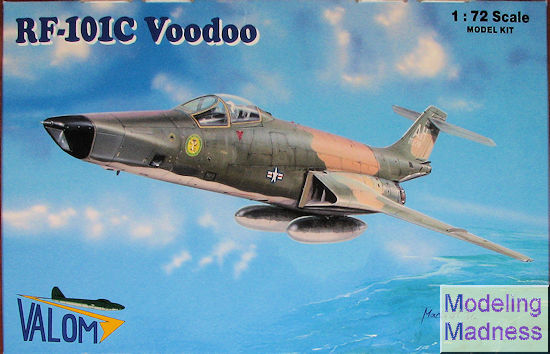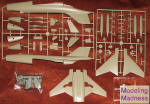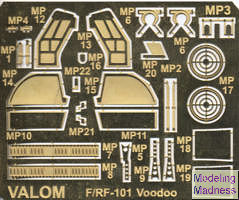
Valom 1/72 RF-101C Voodoo
| KIT #: | 72093 |
| PRICE: | $ |
| DECALS: | Two options |
| REVIEWER: | Scott Van Aken |
| NOTES: |
New tool kit with photo etch and resin parts |

| HISTORY |
Using the reinforced airframe of the F-101C, the RF-101C first flew on 12 July 1957, entering service in 1958. Like the RF-101A, the RF-101C had up to six cameras in place of radar and cannons in the reshaped nose and retained the bombing ability of the fighter-bomber versions. 166 RF-101Cs were built, including 96 originally scheduled to be F-101C fighter-bombers.
The 1964 Project "Toy Tiger" fitted some RF-101C with a new camera package and a centerline pod for photo-flash cartridges. Some were further upgraded under the Mod 1181 program with automatic control for the cameras.
The RF-101C saw service during the Cuban Missile Crisis and soon followed the North American F-100 Super Sabres in October 1961, into combat when RF-101s from the 67th Tactical Reconnaissance Wing deployed to Vietnam. The RF-101C was deployed operationally during the Vietnam War, sustaining losses with the first F-101 being lost in November 1964 to ground fire. From 1965 through November 1970, its role was gradually taken over by the RF-4C Phantom II. In some 35,000 sorties, 39 aircraft were lost, 33 in combat, including five to SAMs, one to an airfield attack, and one in air combat to a MiG-21 in September 1967. The RF-101C's speed made it largely immune to MiG interception. 27 of the combat losses occurred on reconnaissance missions over North Vietnam. In April 1967, ALQ-71 ECM pods were fitted to provide some protection against SAMs. Although the Voodoo was again able to operate at medium altitudes, the added drag and weight decreased the speed enough to make RF-101 vulnerable to the maneuverable (and cannon-equipped) MiGs and thus requiring fighter escort.
On 27 November 1957 during Operation Sun Run, an RF-101C piloted by then-Captain Robert Sweet set the Los Angeles-New York-Los Angeles record in 6 hours 46 minutes, and the New York to Los Angeles record in 3 hours, 36 minutes. Another RF-101C, piloted by then-Lieutenant Gustav Klatt, set the Los Angeles to New York record in 3 hours 7 minutes.
After withdrawal from Vietnam, the RF-101C continued to serve with USAF units through 1979.
In service, the RF-101C was nicknamed the "Long Bird;" it was the only version of the Voodoo to see combat.
| THE KIT |


The cockpit is nicely done with a four piece seat, control stick and instrument panel in plastic as well as the rear bulkhead. Note that there are two instrument panels, but only one is for the RF version. Instruments are on the decal sheet. The nose ear well is made of three parts, two sides and a floor into which a four piece plastic nose gear assembly is installed. I'd test fit this first to see if the gear legs can be installed after painting.
The wing has a full lower section and two upper
halves. The wheel wells are each three sections to box it in. There are
compressor faces to stick to the back of each resin intake, and these do look a
bit small, but shouldn't be much of an issue. A resin splitter fits in front of
the resin intake. The instructions whould have you assemble the four plastic
piece main gear to each upper wing hal
The nose on this kit is separate so one can do either
the RF or standard fighter boxing. The cockpit tub fits atop the nose gear
assembly and measurements are provided for prop
Then one builds up the nose section, which requires
12 grams of weight (which is a lot) along with a lot of small camera windows.
Other things to attach are a pair of fuel tanks,
which are apparently fitted directly to the fuelage, along with the gear doors
Instructions are well done with a variety of paint
options provided, though the Mo olors
required for this kit. Markings are for two planes as shown on the box art. Both
are in the standard SEA paint scheme and both are from the 45th TRS, differing
only in serial number and nose badge. The decals are nicely printed and will
prove to be quite thin. Since the plane has the FS 36622 underside I have doubts
of it using the large insignia and USAF on the lower surfaces, but I could be
wrong. Again, there is a dearth of aftermarket for the RF-101C. Ones that have
been done are Microscale/Superscale 72-110 and 72-362, though finding them may
well be difficult as they are from the 1970s. Some of Wolfpak Decals' sheets
also include RF-101s so might want to check them as well.
olors
required for this kit. Markings are for two planes as shown on the box art. Both
are in the standard SEA paint scheme and both are from the 45th TRS, differing
only in serial number and nose badge. The decals are nicely printed and will
prove to be quite thin. Since the plane has the FS 36622 underside I have doubts
of it using the large insignia and USAF on the lower surfaces, but I could be
wrong. Again, there is a dearth of aftermarket for the RF-101C. Ones that have
been done are Microscale/Superscale 72-110 and 72-362, though finding them may
well be difficult as they are from the 1970s. Some of Wolfpak Decals' sheets
also include RF-101s so might want to check them as well.
| CONCLUSIONS |
I am quite pleased to see this one being done. It will not be a fall together kit so I cannot recommend it to beginners, but if you have done kits with photo etch or resin before, this one should be right up your alley. It also provides an opportunity to build something that is a lot more accurate than the near Mesozoic Hasegawa kit.
| REFERENCES |
https://en.wikipedia.org/wiki/McDonnell_F-101_Voodoo
December 2015
Copyright ModelingMadness.com Thanks to
Valom for the preview kit. Get yours at your local shop or on-line retailer. If you would like your product reviewed fairly and fairly quickly, please contact the editor or see other details in the
Note to
Contributors.